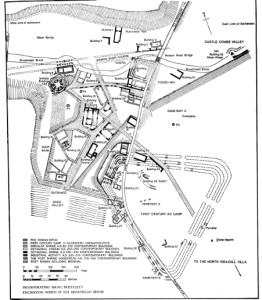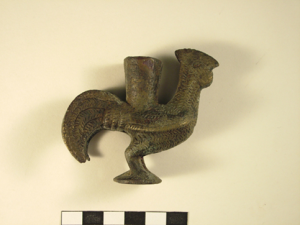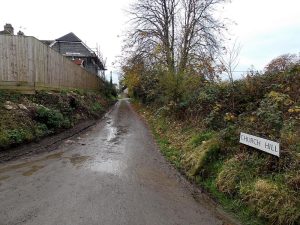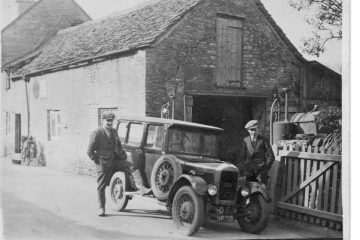Neolithic, Roman and Saxon remains in the Burton area
The many examples of ancient ditches, enclosures and trackways found in and around Burton, suggest this has been a favoured area for settlement since neolithic times.
Significant finds include side ditches uncovered during a 1998 excavation of the Nettleton-Grittleton section of the Fosseway. The area around Goulters Mill shows signs of early ditches, in addition to finds of Neolithic tools and Iron Age coins. Around Nettleton, Saxon earthworks and medieval headlands evidence ridge and furrow fields, plus a rubbish mound from that period. (Wiltshire Council).

Nettleton-Grittleton section of the Fosseway. Ordnance Survey First Series (1830)
Below we focus on a few specific sites of interest.
Lugbury long barrow

Lugbury Long Barrow. Credit: Amanda Read
National Grid Reference:ST 83069 78559
Lugbury long barrow, adjacent to the Fosseway, part-way between The Gibb crossroads and Fosse Farm B&B, is a pleasant walk from Burton.
The barrow consists of three standing stones on a mound which runs east-west.
Most commonly named after nearby Lugbury Farm, the barrow has also been known as Littleton Drew, Nettleton, and Lockstone. Watts (2007) suggests the name may commemorate the Celtic god, Lug, whose name appears in the Celtic festival of Lugnasadh.
Despite partial excavation of the site on two separate occasions and cultivation of part of the barrow mound, this barrow is important as much of the monument survives intact, in particular the buried ground surface and ditches. The site therefore has potential for the recovery of further archaeological remains as well as environmental evidence relating to the period in which the monument was constructed. The importance of the site is enhanced by the survival of numerous Bronze Age burial monuments in the immediate area. Combined, these give an indication of how settlement of the area continued between the 5th and 2nd millennia BC (Historical England, 1992)
The monument was partly excavated by Colt-Hoare in 1821 and again by Scrope in 1854/5. Finds included twenty-six skeletons in four limestone chambers.
Folklore has it that a golden wheelbarrow is concealed within the heart of the mound. (L.V Grinsell (1967) Barrow Treasure, in Fact, Tradition and Legislation).
The Shrine of Apollo, Nettleton Shrub

Plan of Roman monument at Nettleton Shrub (Wedlake, 1982)
The shrine of Apollo, excavated at Nettleton Shrub from 1956 to 1972, is a major find. It consists of a large octagonal structure overlooking the river, a place of pilgrimage in Roman times. Indications of pewter casting and metal working are evident. Stone axe heads, flint implements and small ditches revealing Belgic pottery and British coins have been uncovered. It is thought the site was a prehistoric settlement before becoming a Roman enclosure, probably during construction of the Fosseway in AD 47.
Dating from AD 69, the site of the shrine includes a hostel constructed on the Fosseway, with a rectangular hall nearby, a priest’s house, a shop and domestic buildings. By AD 230 an octagonal podium was built to encompass the shrine. By AD 250 the podium was destroyed by fire and a larger octagonal temple was built on the same site, using the original base.
By AD 330 the building had fallen into disrepair, but was possibly used as a place for Christian worship and later as a homestead.
In the fourth century the area was raided, possibly by Irish pirates via the Bristol Channel. Some may have settled here as indicated by burial sites of stone lined graves. The settlement came to an end by the fifth century, possibly by violent means. Many human bones have been found with sword slashes, some indicating decapitation.
The site is also associated with Diana, perhaps suggesting this was a place for healing, other cults indicate Silvanus and Mercury. A medieval farmstead was built using the Roman buildings as cattle byres and it all eventually reverted to a green pasture as it fell out of use.

Roman cockerel in bronze (The Wiltshire Museum) from the Temple of Apollo, Nettleton Shrub.
Medieval Causeway, Burton
A 2005 excavation (by Cotswold Archaeology) of a section of Church Hill, concluded the site is overlying a post-medieval causeway.
A residual shard of Roman pottery was recovered, likely to have been redeposited from elsewhere.

Church Hill from its junction with Nettleton Road (Jaggery, 1993) CC BY-SA 2.0
Trench looking North on Church Hill (Cotswold Archaeology, 2005)
The excavated area, ranging east of ‘Mullions’ to the junction of Church Hill with Nettleton Road, found the causeway survives for most of the length of the east-west line of Church Hill, although truncated in places by modern construction and root activity. The feature was found to be truncated in an area formerly occupied by buildings at the Church Hill-Nettleton Road junction in the south-eastern corner of the site.
Afterword
If you have any information to add to this post, please do get in touch through the comments section below. Our aim is to pull together a historical record of our village. More posts to follow.
Bibliography
Forgotten Wiltshire – Lugbury Longbarrow
Watts, K (2007) The Wiltshire Cotswolds. Exploring Historic Wiltshire 3. Hobnob Press, Salisbury.


9 Comments
Jo Davies · 11/19/2021 at 10:41 am
Fascinating, learning the history of our village and surroundings.
Amanda Read · 11/19/2021 at 11:53 am
Hi Jo,
I’m glad you enjoyed it. Stay tuned, more local history blogs in the pipeline.
Apollo Mission – Burton in Wiltshire · 11/21/2021 at 2:14 pm
[…] […]
Stone Age Stomp – Burton in Wiltshire · 12/27/2021 at 2:48 pm
[…] Continuing our step back in time, we take you on a walk to view the neolithic Lugbury Long Barrow. […]
Stone Age Stomp - Burton in Wiltshire · 04/19/2022 at 9:47 am
[…] Continuing our step back in time, we take you on a walk to view the neolithic Lugbury Long Barrow. […]
Apollo Mission - Burton in Wiltshire · 04/20/2022 at 2:47 pm
[…] time in our Burton history blog, we discussed sites of archaeological interest. All of which are within walking distance of the […]
Local Landscape Archaeology - Burton in Wiltshire · 03/21/2023 at 3:35 pm
[…] most prominent barrow in Nettleton is the Lugbury Long Barrow (ST 8306 7855) 500m north of Lugbury […]
Massacre in the Temple - Burton in Wiltshire · 03/28/2023 at 7:43 am
[…] the decades following the abandonment of worship at the Temple of Apollo, the building fell into disrepair. At around 370 AD, the shrine was adapted for use as a homestead. […]
From Anarchy to Unification: the Anglo-Saxons in Wiltshire - Burton in Wiltshire · 03/29/2023 at 11:59 am
[…] story so far. We have seen evidence of Neolithic and Roman activity in the parish of Nettleton. Here we take a look at the early medieval period, […]